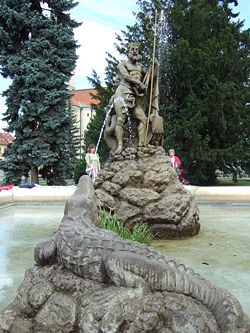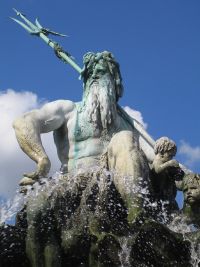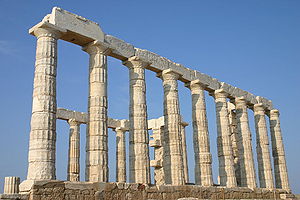Poseidon
In Greek mythology, Poseidon (Greek: Ποσειδών; Latin: Neptūnus) was the god of both the sea and earthquakes. He is instantly recognizable in sculpture due to his possession of a three-pronged spear (the trident).
The sea gods Rodon in Illyrian mythology, Nethuns in Etruscan, and Neptune in Roman mythology were all analogous to Poseidon (or directly derivative of him). He was also associated with the earth-shaking thunder of horses galloping, which further linking him to earthquakes.
Bronze Age Greece
If surviving Linear B clay tablets can be trusted, the name PO-SE-DA-WO-NE ("Poseidon") occurs with greater frequency than does DI-U-JA (Zeus). A feminine variant, PO-SE-DE-IA, is also found, indicating a lost consort goddess. Tablets from Pylos record sacrificial goods destined for "the Two Queens and Poseidon" and to "the Two Queens and the King". The most obvious identification for the "Two Queens" is with Demeter and Persephone, or their precursors, goddesses who were not associated with Poseidon in later periods.[1]
Poseidon is already identified as "Earth-Shaker"— E-NE-SI-DA-O-NE— in Mycenaean Knossos [2], a powerful attribution in a society where earthquakes were credited with the collapse of the Minoan palace-culture. In the heavily sea-dependent Mycenean culture, no connection between Poseidon and the sea has yet surfaced; among the Olympians, it was determined by lot that he should rule over the sea.[3] In other words, the god preceded his realm.
Poseidon was a major civic god of several cities: in Athens, he was second only to Athena in importance; while in Corinth and many cities of Magna Graecia, he was the chief god of the polis.[4]
According to Pausanias, Poseidon was one of the caretakers of the Oracle at Delphi before Olympian Apollo became its patron. Apollo and Poseidon worked closely in many realms: in colonization, for example, Apollo provided the authorization to go out and settle from Delphi, while Poseidon watched over the colonists on their way, and provided the lustral water for the foundation-sacrifice.[5] Further, Xenophon's Anabasis describes a group of Spartan soldiers singing to a paean to Poseidon - a type of hymn normally reserved for Apollo.
Later Myth
Birth and triumph over Cronus
Poseidon was a son of Cronus and Rhea. In most accounts, he is swallowed by Cronus at birth. However in some versions of the story, he, like his brother Zeus, did not share the fate of his other brother and sisters who were eaten by Cronos. He was saved by his mother Rhea who tricked Cronus into eating a foal instead, saying that she had given birth to a horse. Zeus and his brothers and sisters, along with the Hecatonchires, Gigantes and Cyclopes overthrew Cronus and the other Titans. According to other variants, Poseidon was raised by the Telchines on Rhodes, just as Zeus was raised by the Korybantes on Crete.[6]
When the world was divided in three, Zeus received the sky, Hades the underworld and Poseidon the sea.[7]
Lovers
As with many Greek gods, Poseidon was depicted a lascivious being who thought nothing of taking women (both divine and human) by force if they refused his advances. The list below will chronicle some of these barbaric exploits:
- His wife was Amphitrite, a nymph and ancient sea-goddess, daughter of Nereus and Doris.[8]
- He was also thought to have raped Aethra, thus fathering the famed Theseus.[9]
- He is described (in an archaic myth) pursuing Demeter. She spurned his advances, turning herself into a mare so that she could hide in a herd of horses; he saw through the deception and became a stallion and captured (or raped) her. Their child was a horse, Arion, which was capable of human speech.[10]
- He rescued Amymone from a lecherous satyr and then fathered a child, Nauplius, by her.[11]
- He trick Tyro (a mortal woman) into having intercourse with him by disguising himself as a different deity (that she happened to have an attraction to).[12]
- He had intercourse with Medusa on the floor of a temple to Athena. The aggravated goddess proceeded to transform his lover into a monster.[13]
- He slept with Caeneus, and then fulfilled her request and transformed her into a man.[14]
Homeric Hymn to Poseidon
The hymn to Poseidon included among the Homeric Hymns is a brief invocation, a seven-line introduction that addresses the god as both "mover of the earth and barren sea, god of the deep who is also lord of Helicon and wide Aegae,[15] and specificies his twofold nature as an Olympian: "a tamer of horses and a saviour of ships."[16]
Other Accounts
In one oft-told tale, Athena and Poseidon compete for the favor of the Athenian people, with each god promising total sovereignty to the victor. The terms of their contest were simple: whoever could provide the citizens of Athens with a more valuable gift would become their official patron. Poseidon offered the first gift - striking the ground with his trident and producing a spring. Unfortunately, the water was salty (perhaps due to his oceanic provenance) and was not terribly potable. Athena, on the other hand, offered them an olive tree. Seeing both options, the Athenians (as represented by their king, Cecrops) accepted the olive tree and along with it Athena as their patron, as her gift provided them wood, oil and food. Given that at its height Athens was a significant sea power, it seems reasonable to assume (following some scholars)[17] that this tale represents a clash between the value systems of the early Mycenaeans and newer immigrants.
In another tale, Apollo (the frequent companion of Poseidon) offends Zeus by murdering the Cyclops. In punishment, Apollo is sentenced to a year of hard labor disguised as a mortal, a punishment Poseidon agreed to bear with him compatriot. After working for a year for the Trojan king Laomedon, both deities were bilked of their hard-earned wages, which prompts the following diatribe from Poseidon (as related in the Illiad):
- You have no sense, and forget how we two alone of all the gods fared hardly round about Ilius when we came from Jove's [Zeus's] house and worked for Laomedon a whole year at a stated wage and he gave us his orders. I built the Trojans the wall about their city, so wide and fair that it might be impregnable, while you, Phoebus [Apollo], herded cattle for him in the dales of many valleyed Ida. When, however, the glad hours brought round the time of payment, mighty Laomedon robbed us of all our hire and sent us off with nothing but abuse. He threatened to bind us hand and foot and sell us over into some distant island. He tried, moreover, to cut off the ears of both of us, so we went away in a rage, furious about the payment he had promised us, and yet withheld; in spite of all this, you are now showing favour to his people, and will not join us in compassing the utter ruin of the proud Trojans with their wives and children.[18]
To avenge his mistreatment, Poseidon proceeded to send a sea monster to attack Troy in the years before the Trojan War. Despite this bias, the sea god does rescue Aeneas from the Greeks after the Trojan prince is laid low by Achilles.[19]
In the Odyssey, Poseidon is a constant adversary to the titular hero, as he seeks revenge for the blinding of his son Polyphemus by the crafty mortal. Given that the bulk of Odysseus's return voyage was by sea, it was easily achievable for the enraged deity to delay the hero's homecoming to Ithaca by many years.[20]

Consorts/children
Not all of Poseidon's children are human. Among them are also included Triton, the merman; Pegasus, the winged horse; Polyphemus, the cyclops; Oto and Ephialtae, the giants; and Arion (the talking horse).[21]
- With Aethra
- With Alope
- Hippothoon
- With Amphitrite
- Rhode
- Triton
- Benthesikyme
- With Amymone
- Nauplius
- With Astypalaea
- Ancaeus
- Eurypylos
- With Canace
- Aloeus
- Epopeus
- Hopelus
- Nireus
- Triopas
- With Celaeno
- Lycus
- With Chione
- Eumolpus
- With Chloris
- Poriclymenus
- With Clieto
- Atlas
- Eymelus
- Ampheres
- Evaemon
- Mneseus
- Autochthon
- Elasippus
- Mestor
- Azaes
- Diaprepes
- With Demeter
- Arion
- Despina
- With Europa
- Euphemus
- With Euryale
- Orion
- With Gaia
- Antaeus
- Charybdis
- With Halia
- Rhode
- With Hiona
- Hios
- With Hippothoe
- Taphius
- With Libya
- Belus
- Agenor
- Lelex
- With Lybie
- Lamia (mythology)|Lamia
- With Melia
- Amycus
- With Medusa
- Pegasus
- Chrysaor
- With Periboea
- Nausithous
- With Satyrion
- Taras
- With Thoosa
- Polyphemus
- With Tyro
- Neleus
- Pelias
- Unknown mother
- Aon
- Byzas
- Cercyon
- Cycnus
- Evadne
- Lotis
- Rhodus
- Sinis
Role in society
In his benign aspect, Poseidon created new islands, calmed seas and protected travellers. However, when offended or ignored, he struck the ground with his trident and caused chaotic springs, earthquakes, drownings and shipwrecks. This led to him being seen as the patron of sailors, who would pray to the Sea God for a safe voyage, sometimes drowning horses as a sacrifice.[22] Despite this somewhat frightening persona, the feast day in his honor was was widely celebrated at the beginning of the winter.[23] On a larger scale, "there was a festival once every fifth year at Sunium in honor of Poseidon - evidently, then, a major event.[24] Also, animal offerings to Poseidon were a common feature at the feast days of other gods, including (by way of example) the "festival at the temple of Hera on the 27th of Gamelion," which honored the goddess "together with Zeus the Accomplisher, Kourotrophos and Poseidon."[25]
Neptune
Neptune was worshipped by the Romans primarily as a horse god (Neptune Equester), patron of horse-racing. He had a temple near the race tracks in Rome (built in 25 B.C.E.), the Circus Flaminius, as well as one in the Campus Martius, where on July 23, the Neptunalia (the feast day dedicated to the deity) was observed.[26]
Notes
- ↑ Palmer, 103.
- ↑ Ventris and Chadwick, page 463 (Document #172 (from Pylos)).
- ↑ Powell, 149.
- ↑ Dillon, 131, 138-139. Mikalson, 70-71, 170, 174.
- ↑ Dillon, 30, 32, 36.
- ↑ Hesiod: Theogony 453.
- ↑ Powell, 149.
- ↑ Hesiod: Theogony 930
- ↑ Apollodorus 3.15.7.
- ↑ Apollodorus 3.7.1
- ↑ Apollodorus 2.1.5
- ↑ Homer: Odyssey 11.250
- ↑ Apollodorus 2.4.1
- ↑ Apollodorus 2.151
- ↑ The ancient palace-city that was replaced by Vergina.
- ↑ The Homeric Hymns (XXII), Translated by Hugh G. Evelyn-White, accessed online at sacred-texts.com, April 22 2007.
- ↑ This would explain the discrepancy between Poseidon as "principal god of the Mycenaean pantheon" (Rutkowski, 209) and his status as a relatively uncommon figure in extant Greek mythology (Gantz, 63).
- ↑ Homer, Iliad Book XXI, translated by Samuel Butler and accessed online at sacred-texts.com, April 22 2007.
- ↑ Iliad Book XX.
- ↑ Homer, The Odyssey IX; Euripides, The Cyclops. See also: Rose, 244.
- ↑ N.S. Gill, Mates and Children of Poseidon, accessed April 22, 2007.
- ↑ Farnell (Vol. IV), 16.
- ↑ Robertson, 1984.
- ↑ Parke, 97.
- ↑ Parke, 179.
- ↑ Micha F. Lindemans, "Neptune" in Encyclopedia Mythica, accessed online: April 23, 2007.
ReferencesISBN links support NWE through referral fees
- Burkert, Walter. Greek Religion: Archaic and Classical. Translated by John Raffan. Oxford: Blackwell, 1985. ISBN 0631112413.
- Dillon, Matthew. Pilgrims and Pilgrimage in Ancient Greece. London; New York: Routledge, 1997. ISBN 0415127750.
- Farnell, Lewis Richard. The Cults of the Greek States (in Five Volumes). Oxford: Clarendon Press, 1907.
- Gantz, Timothy. Early Greek Myth: A Guide to Literary and Artistic Sources. Baltimore: Johns Hopkins University Press, 1993. ISBN 080184410X.
- Mikalson, Jon D. Ancient Greek Religion. Malden, MA: Blackwell, 2005. ISBN 0631232222.
- Palmer, L. R. The Interpretation of Mycenaean Greek Texts. Oxford: Clarendon Press, 1963.
- Parke, H. W. Festivals of the Athenians. Ithaca, NY: Cornell University Press, 1977. ISBN 0-8014-1054-1.
- Powell, Barry B. Classical Myth (Second Edition). Upper Saddle River, NJ: Prentice Hall, 1998. ISBN 0-13-716714-8.
- Robertson, Noel. "Poseidon's Festival at the Winter Solstice." The Classical Quarterly (New Series), 34.1 (1984), pp. 1-16.
- Rose, H. J. A Handbook of Greek Mythology. New York: E. P. Dutton & Co., 1959. ISBN 0-525-47041-7.
- Rutkowski, Bogdan. The Cult Places of the Aegean. New Haven: Yale University Press, 1986. ISBN 0300029624.
- Ventris, Michael & Chadwick, John. Documents in Mycenaean Greek (Second Edition). Cambridge: Cambridge University Press, 1973. ISBN 0521085586.
External Links
- Mythic themes clustered around Poseidon/Neptune - Retrieved April 23, 2007.
- Greek Mythology resource - Retrieved April 23, 2007.
- Theoi.com: Poseidon - Retrieved April 23, 2007.
- Gods found in Mycenaean Greece; a table drawn up from Linear B textual evidence - Retrieved April 23, 2007.
Credits
New World Encyclopedia writers and editors rewrote and completed the Wikipedia article in accordance with New World Encyclopedia standards. This article abides by terms of the Creative Commons CC-by-sa 3.0 License (CC-by-sa), which may be used and disseminated with proper attribution. Credit is due under the terms of this license that can reference both the New World Encyclopedia contributors and the selfless volunteer contributors of the Wikimedia Foundation. To cite this article click here for a list of acceptable citing formats.The history of earlier contributions by wikipedians is accessible to researchers here:
The history of this article since it was imported to New World Encyclopedia:
Note: Some restrictions may apply to use of individual images which are separately licensed.


